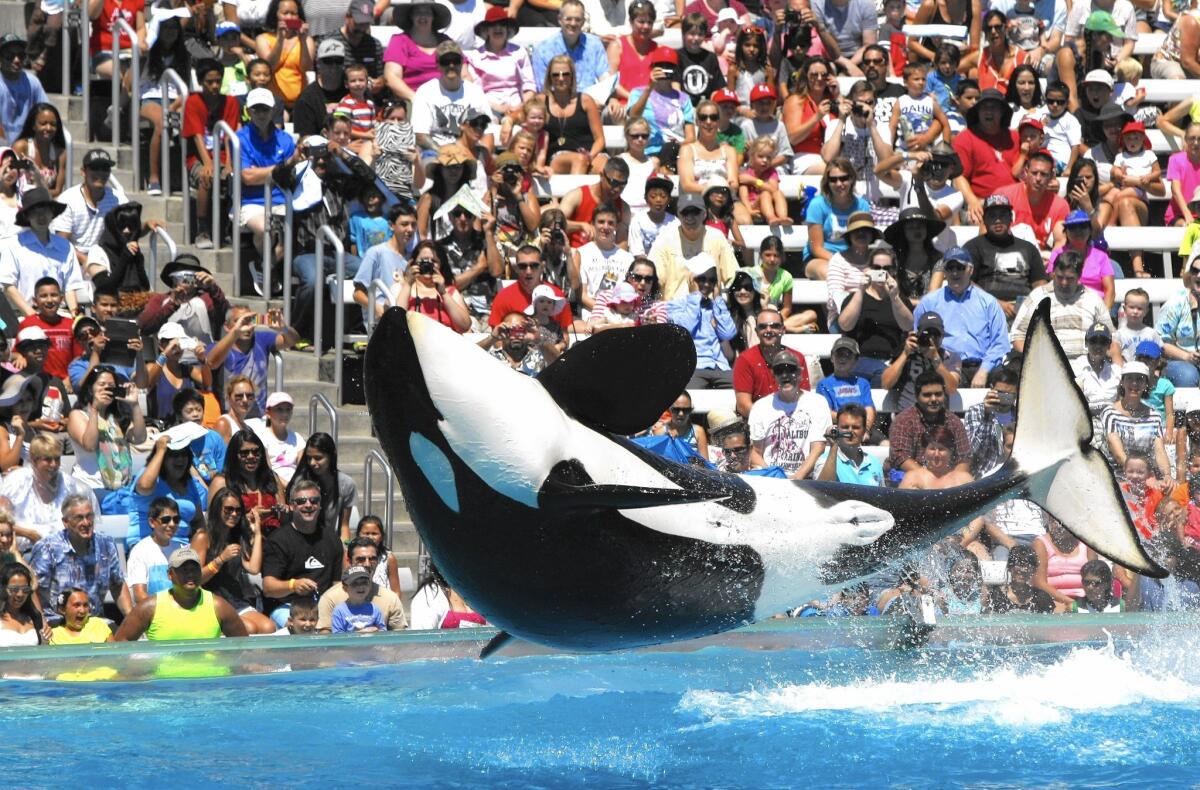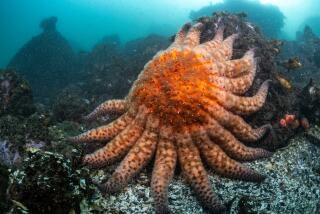What the Coastal Commission’s ban on orca breeding means for SeaWorld

- Share via
If there’s a star at SeaWorld San Diego, it’s the 11 mammoth killer whales that thrill children and parents with their magnificent grace and acrobatic tricks.
So does the animal park have a future without Shamu?
That’s the existential threat the San Diego theme park is facing after this week’s stunning decision by the California Coastal Commission to ban captive breeding of the park’s killer whales — as a condition of building a much larger $100-million holding facility.
The vote, condemned by the park, comes as SeaWorld tries to fend off criticism highlighted in the 2013 documentary “Blackfish” accusing the marine park of neglecting and abusing its killer whales.
SeaWorld has rejected those accusations but faced plummeting attendance and a constant barrage of public criticism. It planned to win back public support by building a much larger living environment for its orcas — a 450,000-gallon pool and a 5.2-million-gallon tank in place of its 1.7-million-gallon pen.
The Coastal Commission approved the plan, but placed restrictions on the park that could mean an end to SeaWorld’s orca program. Without breeding or bringing in new orcas, its animals would grow old and die in the park, ending the shows permanently.
“It means that the California Coastal Commission is asking them to manage these animals to extinction in the state of California,” said Grey Stafford, director of conservation at the Wildlife World Zoo and Aquarium in Phoenix.
SeaWorld could abandon the project and allow the animals to live and continue performing in their current enclosure — in essence thumbing its nose at a growing chorus of critics.
But few see the company pursuing either option.
The twice-a-day shows by the animals, which weigh several tons, are by far the biggest attraction at the park, which also features other marine shows, animal exhibits, a roller coaster and water ride.
The commission’s decision might complicate SeaWorld’s future plans, but doesn’t spell the company’s demise, said James Hardiman, equity research analyst and managing director at Wedbush Securities.
“A lot would need to happen for SeaWorld’s business to be over,” he said. “This does not mark the end of SeaWorld.”
He said he doesn’t expect the company to continue with its tank expansion under the current conditions, even though it was billed as a way to improve the image of SeaWorld, which drew 3.8 million visitors last year.
“It would be signaling the end of this program, so why would you then spend $100 million on it?” Hardiman said.
SeaWorld Entertainment, based in Orlando, Fla., operates 11 parks across the country, including three that are home to orca whales: SeaWorld San Diego, SeaWorld San Antonio and SeaWorld Orlando.
Bill Hurly, past president of the Alliance of Marine Mammal Parks & Aquariums, an international accreditation body, said he expects that SeaWorld will follow through on its threat to challenge the legality of the decision, a move that would be supported by the industry.
“If I were SeaWorld, I’d use my legal resources,” he said.
Indeed, aquarium and zoo officials have blasted the Coastal Commission’s restrictions, saying breeding programs help biologists improve their understanding of the behavior and habits of killer whales. They blamed the panel’s vote on “misinformation” disseminated on social media by animal rights activists.
“Most of what is known about marine mammal reproduction has been learned by studying animals in zoological facilities,” said Rob Vernon, a spokesman for the Assn. of Zoos & Aquariums.
Even so, the vote will likely give animal rights groups new momentum to call on local agencies throughout the nation to change the way animals in captivity are treated after several unsuccessful reform efforts.
A bill introduced in the California Legislature to ban killer whale shows at SeaWorld San Diego was tabled last year for further study, and its author confirmed later that he won’t reintroduce it this year. In Vancouver, British Columbia, a parks board voted last year to halt the breeding program at the Vancouver Aquarium, but the ban was never implemented.
“Blackfish” director Gabriela Cowperthwaite said the commission’s decision shows that the public is now taking a greater interest in how animals are treated.
“It’s a sign that everyone is exercising any authority they might have over this place to force them to do the right thing,” Cowperthwaite said.
“SeaWorld can no longer say this is the work of activists and the animal rights community. It was a spanking coming from a much higher level,” she said.
Park officials have declined to say how much of the company’s revenues are generated by the SeaWorld marine parks. But the company blamed an 11% drop in attendance partly on negative publicity from “Blackfish.” Since 2013, SeaWorld Entertainment shares have dropped about 36%.
Despite the vote, the issue is far from resolved. Legal experts said the Coastal Commission may not even have jurisdiction over whether SeaWorld can breed or move whales. The final authority, zoo and aquarium managers say, is with the U.S. Department of Agriculture, given by the 1966 Animal Welfare Act and the 1972 Marine Mammal Protection Act.
Jonathan Zasloff, a UCLA law professor who has studied the Coastal Commission, said that if SeaWorld appeals the ruling, the commission would need to demonstrate that the breeding and transfer restrictions are in line with the agency’s focus on preserving and protecting coastal values and resources.
“Can they make an argument that this actually assures the ecological health of the coastal zone?” he said. “If it’s about animal welfare, apart from coastal resources, then it’s a little trickier.”
But Richard Frank, professor of environmental practice at the UC Davis School of Law, said that in the past, courts have broadly interpreted the commission’s permit approvals.
“I think the Coastal Commission’s actions yesterday reflect kind of a broader skepticism of capturing and maintaining in captivity orca whales and similar marine mammals,” he said Friday.
As the SeaWorld gates opened Friday morning, it was clear the killer whales were the main attraction.
Clay Marshall, 39, walked briskly through the parking lot with his family of six.
“We would not come if the orcas were not here,” he said. “And we’re coming from Colorado.”
But Jared Hall and his wife, Tiffany, said the proposed ban on whale breeding helped address their increasing unease with the treatment of orcas at SeaWorld.
“My ideal solution,” said Tiffany Hall, “would be for SeaWorld to eighty-six the whole orcas show.”
The couple drove six hours from Tucson, Ariz., with their 5- and 7-year old boys, specifically to visit SeaWorld. “It kind of takes you back to the days of P.T Barnum,” Jared Hall said. “Maybe they should make them not do shows or tricks and just have them on display.”
Los Angeles Times staff writer Amy Kaufman and San Diego Union-Tribune staff writer Morgan Lee contributed to this report.
ALSO:
Massive El Niño is now ‘too big to fail,’ scientist says
Kanye West-themed frat party at UCLA sparks protests, claims of racism
School movie shoots resume after embarrassing revelation about porn flick
More to Read
Inside the business of entertainment
The Wide Shot brings you news, analysis and insights on everything from streaming wars to production — and what it all means for the future.
You may occasionally receive promotional content from the Los Angeles Times.










